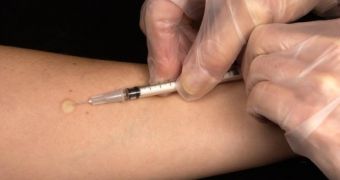A new blood test aimed at detecting people with high tuberculosis (TB) risks, developed by British scientists, could take preventive medicine for this disease to a whole new level. The new test is meant to replace the 100-year-old tuberculin skin test, which is less accurate and can give back false positive results if the tested patient has been vaccinated against TB.
With TB cases reaching the size of a global pandemic, more than 8 million people get infected with this disease each year, and 2 millions die from it. These statistics prompted Imperial College London researchers to try and devise a new way of telling whether people having the dormant form of the mycobacterium tuberculosis will develop the active form of the disease or not. Considering that one in three people worldwide has the bacterium in some form, it's easy to see the urgency of creating new test methods.
Most TB cases are reported in third world and developing countries, where medical supplies and vaccine doses are critically low. The British researchers say that, with the introduction of the new test method, valuable medical equipment could be spared from being wasted on people whose tuberculin skin test results came back positive, though they are not at any risk of developing an active form of tuberculosis.
To prove this, Ajit Lalvani, professor at the Center for Respiratory Infection at Imperial College London, compared the two test methods on 908 Turkish children from Istanbul, who have been accidentally exposed to TB in their homes. Some 590 tested positive for the bacterium, after results from both tests came back. The skin test revealed 505 possible high-risk patients, while the blood test only yielded 381 positive results. This means that 10 percent of the people who were diagnosed with high TB risks until now were perfectly fine and in no immediate danger.
The blood test did very well. Out of the 12 children who eventually developed the active form of TB, 11 were identified beforehand. "Our study shows that new tools like the blood test can help tackle the global [tuberculosis] pandemic. We now know that the blood test really helps to target treatment to those who most need it in order to prevent them from developing active TB," explained Lalvani.
This new test is a critical step in understanding how TB acts and why it only develops in certain patients. Along with other new discoveries made recently, a breeze of optimism "sweeps" the international scientific community, in hopes that someday soon, a new breakthrough would lead to the eradication of this globally-spread disease.

 14 DAY TRIAL //
14 DAY TRIAL //